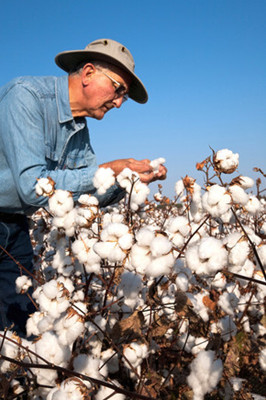棉花,一部全球史
Spinning tales
紡織傳奇
A fine account of 900 years of globalization
道盡900年全球化歷史
Still a player, thanks to subsidies
由于補(bǔ)貼,(美國)依舊是一大棉花產(chǎn)國
Empire of Cotton: A Global History. By Sven Beckert.
《棉花帝國:一部全球史》。作者Sven Beckert
GOOD economic history tells dramatic stories of ingenuity and aspiration, greed and national self-interest. Sven Beckert writes good economic history. But why cotton? Mr Beckert's answer is that for 900 years, until 1900, it was the world's most important manufacturing industry. Cotton is relevant now because the story explains how and why an industry goes global. It is a story of wildly fluctuating fortunes, from stunning wealth to dire social disasters.
一部優(yōu)秀的經(jīng)濟(jì)史需要講出好的故事,既匠心獨(dú)具又發(fā)人深省,既描寫貪婪又涉及國家利己主義。Sven Beckert的這本書就是如此。為什么寫棉花?Beckert的回答是,在1900年之前的900年里,棉花產(chǎn)業(yè)一直都是世界上最重要的制造業(yè)。如今,棉花還能解釋一個(gè)產(chǎn)業(yè)走向全球的形式和原因。這個(gè)故事有關(guān)財(cái)富的劇烈變動(dòng),從驚人的巨額財(cái)富到可怕的社會(huì)災(zāi)難。

India runs like a thread through this tale. Cotton was being spun in the Indus Valley in 3000BC; Herodotus admired its quality. Spinning and weaving cotton (the word comes from qutn in Arabic) were introduced to Europe by Muslim invaders in the tenth century. In India cotton as a cottage industry was so successful that it established a substantial market in Britain. This had two consequences. The first was technological innovation in the industrial north; spinning machines, the invention of the flying shuttle, the spinning jenny and power looms were the forerunners of the Industrial Revolution. The second, introduced in 1774 to assist English spinners and weavers, was protectionist legislation that made it illegal to sell imported cotton.
故事中一直充斥著印度的身影。早在公元前3000年,印度河流域的人們就已經(jīng)學(xué)會(huì)紡紗,希羅多德就曾贊賞它的質(zhì)地。當(dāng)穆斯林在10世紀(jì)入侵歐洲時(shí),也把紡紗和織布的技術(shù)帶到了歐洲(棉花cotton一詞就源自阿拉伯語qutn)。家庭手工業(yè)形式的棉花生產(chǎn)在印度非常成功,甚至在英國的市場占據(jù)了不小的份額。這造成了兩個(gè)結(jié)果。首先是讓北部工業(yè)區(qū)誕生了許多的技術(shù)革新。諸如飛梭、珍妮紡紗機(jī)、動(dòng)力織機(jī)等紡紗機(jī)器的發(fā)明都是工業(yè)革命的先驅(qū)。其次,英國為了幫助本國的紡織業(yè)從業(yè)者而在1774年頒布了貿(mào)易保護(hù)法,將出售進(jìn)口棉花認(rèn)定為違法行為。
By 1800 mass-produced British cotton dominated world markets, including in India where the industry collapsed. In the three decades to 1820 innovation helped productivity in Britain's new cotton factories increase 370 times. Mr Beckert, a history professor at Harvard, calls this new economic order “War Capitalism” as it is based on imperial expansion, expropriation of land, and slavery.
到了1800年,產(chǎn)量巨大的英國棉花稱霸了全球市場,包括棉紡產(chǎn)業(yè)已經(jīng)崩潰的印度。在1820年之前的三十年中,技術(shù)創(chuàng)新使得英國棉花工廠的產(chǎn)量提高了370倍。身為哈佛大學(xué)歷史系教授的Beckert把這種新式的經(jīng)濟(jì)秩序稱為“戰(zhàn)爭資本主義”,因?yàn)樗腔谟⒌蹏臄U(kuò)張、征用(殖民地)土地的和奴役(被侵略地區(qū)的人民)。
Slaves and wide open spaces in the southern states transformed America's economy, too. Capital, raised mainly in London, financed the expansion. By the late 1850s, 77% of the cotton consumed in Britain came from America. Profits soared on both sides of the Atlantic. Manchester became a centre of the universe, always feeding on cheap labour, mostly women, who, unlike slaves, were paid a wage, albeit a poor one. (This reviewer's great-aunt was among the first women to earn a guinea a week from piece-work in her Rochdale mill, in the 1920s.)
奴隸和南部開闊的土地同樣改變了美國的經(jīng)濟(jì)。隨著英帝國不斷擴(kuò)張?jiān)诿绹念I(lǐng)土,倫敦從中獲得了大量資本。到了18世紀(jì)50年代末期,英國消費(fèi)的棉花中有77%來自于美國。大西洋兩岸都獲得了大量的利潤。依靠廉價(jià)的勞力,尤其是婦女們,曼切斯特成為了這一切的中心。這些勞力和黑奴不同,他們有一些薪水,雖然并不多。(本書評(píng)作者的伯祖母就是19世紀(jì)20年代的羅奇代爾磨房中第一批能從計(jì)件工作中賺到每周一基尼的婦女們的一員。)
Deprived of raw American cotton when the civil war broke out in 1861, English manufacturers rediscovered India. Railways were built in the newly acquired state of Berar to shift raw cotton for export to Bombay. By 1862, 75% of Britain's cotton originated in India. The industry had gone global; Egypt and Brazil also provided new sources of supply. When news of the Union Army's victories in 1865 reached India, property prices in Bombay collapsed, anticipating the renewed competition that the end of the war might bring. In the event, as peace returned to the American South and former slaves became sharecroppers, the global industry recovered quickly, helped by a surge in demand.
到了1861年,美國內(nèi)戰(zhàn)爆發(fā),無法從美國得到原棉的英國制造者只好重新開發(fā)印度。他們?cè)趧倓傉碱I(lǐng)的貝拉爾邦建造了很多鐵路,用來將原棉運(yùn)往孟買。1862年時(shí),英國75%的棉花都來自印度。此時(shí),這個(gè)行業(yè)已經(jīng)走向了國際化;埃及和巴西也加入了供應(yīng)源的行列。到了1865年,當(dāng)同盟軍贏得內(nèi)戰(zhàn)的消息到達(dá)印度時(shí),孟買的房價(jià)一瀉千里。這是由于人們都估計(jì)美國內(nèi)戰(zhàn)結(jié)束將引來新的競爭。結(jié)果是,隨著美國南部恢復(fù)和平,奴隸成了佃農(nóng)后,高漲的需求使得全球棉花產(chǎn)業(yè)快速恢復(fù)了。
In the late 19th century the cotton industry in England began to decline. At the height of the Great Depression in 1932 only 11% of the world's mechanical spindles were operating in Britain, compared with 61% in 1860. The terrible blight that has overwhelmed cotton towns such as Rochdale began then, and has grown worse since. By the late 1960s Britain accounted for only 2.8% of global cotton exports.
到了19世紀(jì)末期,英國棉花業(yè)開始倒退。1932年大蕭條最為嚴(yán)重時(shí)期,英國只擁有的全球機(jī)械紗錠中的11%,而1860年時(shí)則有61%。當(dāng)時(shí),可怕的枯萎病襲擊了包括洛奇代爾在內(nèi)的產(chǎn)棉城鎮(zhèn),而且情況越變?cè)皆恪5搅?9世紀(jì)60年代末期,英國只占全球棉花出口的2.8%。
Today the main sources of raw cotton are China (29%) and India (21%). Supported by grotesque subsidies ($35 billion between 1995 and 2010), America clings on in third place. Producers sell to the new merchants of cotton: global retailers such as Gap and Adidas. Mr Beckert's story is both inspirational and utterly depressing, a reflection of the white-knuckle ride that has been the characteristic of globalisation through the centuries.
現(xiàn)如今主要的原棉產(chǎn)國是中國(29%)和印度(21%)。由于離譜的棉花補(bǔ)助(1995至2010年間總計(jì)達(dá)350億美元),美國仍位居第三。生產(chǎn)者們將產(chǎn)品賣給新一代的棉花商人們:諸如Gap和阿迪達(dá)斯這樣的國際零售商。Beckert的故事既振奮人心又讓人非常絕望,這是對(duì)綿延數(shù)世紀(jì)的全球化進(jìn)程中間一段跌宕起伏的發(fā)展史進(jìn)行的一次沉思。翻譯:胡靚 校對(duì):李燊












